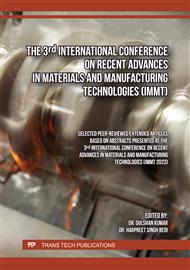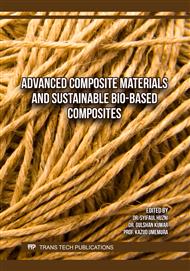[1]
Ali, A.; Shaker, K.; Nawab, Y.; Jabbar, M.; Hussain, T.; Militky, J.; Baheti, V., Hydrophobic treatment of natural fibers and their composites—A review. Journal of Industrial Textiles 2018, 47 (8), 2153-2183.
DOI: 10.1177/1528083716654468
Google Scholar
[2]
Kamarudin, S. H.; Mohd Basri, M. S.; Rayung, M.; Abu, F.; Ahmad, S. b.; Norizan, M. N.; Osman, S.; Sarifuddin, N.; Desa, M. S. Z. M.; Abdullah, U. H.; Mohamed Amin Tawakkal, I. S.; Abdullah, L. C. A Review on natural fiber reinforced polymer composites (NFRPC) for sustainable industrial applications. Polymers 2022, 14 (17), 3698.
DOI: 10.3390/polym14173698
Google Scholar
[3]
Omrani, E.; Menezes, P. L.; Rohatgi, P. K. State of the art on tribological behavior of polymer matrix composites reinforced with natural fibers in the green materials world. Engineering Science and Technology, an International Journal 2016, 19 (2), 717-736.
DOI: 10.1016/j.jestch.2015.10.007
Google Scholar
[4]
Mohammed, L.; Ansari, M. N. M.; Pua, G.; Jawaid, M.; Islam, M. S. A review on natural fiber reinforced polymer composite and its applications. International Journal of Polymer Science 2015, 2015, 243947.
DOI: 10.1155/2015/243947
Google Scholar
[5]
Engel, J. B.; Luchese, C. L.; Tessaro, I. C. Characterization techniques comparison towards a better understanding of different cork-based stoppers types. Journal of Food Engineering 2022, 328, 111063.
DOI: 10.1016/j.jfoodeng.2022.111063
Google Scholar
[6]
Gürgen, S.; Sofuoğlu, M. A. Smart polymer integrated cork composites for enhanced vibration damping properties. Composite Structures 2021, 258, 113200.
DOI: 10.1016/j.compstruct.2020.113200
Google Scholar
[7]
Prabhakaran, S.; Krishnaraj, V.; Shankar, K.; Senthilkumar, M.; Zitoune, R. Experimental investigation on impact, sound, and vibration response of natural-based composite sandwich made of flax and agglomerated cork. Journal of Composite Materials 2020, 54 (5), 669-680.
DOI: 10.1177/0021998319871354
Google Scholar
[8]
Wang, Q.; Chu, D.; Luo, C.; Lai, Z.; Shang, S.; Rahimi, S.; Mu, J. Transformation mechanism from cork into honeycomb–like biochar with rich hierarchical pore structure during slow pyrolysis. Industrial Crops and Products 2022, 181, 114827.
DOI: 10.1016/j.indcrop.2022.114827
Google Scholar
[9]
Fernandes, E. M.; Mano, J. F.; Reis, R. L. Hybrid cork–polymer composites containing sisal fibre: Morphology, effect of the fibre treatment on the mechanical properties and tensile failure prediction. Composite Structures 2013, 105, 153-162.
DOI: 10.1016/j.compstruct.2013.05.012
Google Scholar
[10]
Wang, A. J.; Liao, K.-S.; Maharjan, S.; Zhu, Z.; McElhenny, B.; Bao, J.; Curran, S. A. Percolating conductive networks in multiwall carbon nanotube-filled polymeric nanocomposites: towards scalable high-conductivity applications of disordered systems. Nanoscale 2019, 11 (17), 8565-8578.
DOI: 10.1039/c9nr00216b
Google Scholar
[11]
Wang, A.J.; Maharjan, S.; Liao, K.-S.; McElhenny, B. P.; Wright, K. D.; Dillon, E. P.; Neupane, R.; Zhu, Z.; Chen, S.; Barron, A. R.; Varghese, O. K.; Bao, J.; Curran, S. A. Poly(octadecyl acrylate)-grafted multiwalled carbon nanotube composites for wearable temperature sensors. ACS Applied Nano Materials 2020, 3(3), 2288-2301.
DOI: 10.1021/acsanm.9b02396
Google Scholar
[12]
Alghamdi S. S.; Balu R.; Vongsvivut J.; Troung V. K.; Metttu S.; John S.; Choudhury N. R.; Dutta N. K., Exploring the role of compatibilizers in modulating the interfacial phenomena and improving properties of Cork-Nylon Composites, ACS Appl. Polym. Mater. 2023, 5, 9, 6990–7008.
DOI: 10.1021/acsapm.3c01049
Google Scholar



